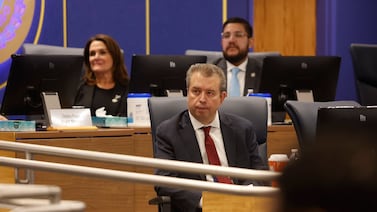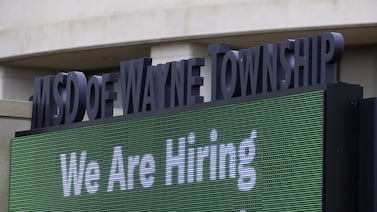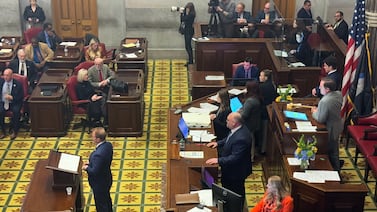Sign up for Chalkbeat New York’s free daily newsletter to keep up with NYC’s public schools.
Dozens of pro-Palestinian educators and parent leaders staged a die-in outside the Education Department’s Lower Manhattan headquarters on Wednesday, just hours after New York City’s schools Chancellor David Banks testified at a congressional hearing focused on antisemitism.
In a nod to the bombardment of the Gaza Strip, a handful of protestors in white jumpsuits splashed with red and gray paint sprawled across the steps of Tweed Courthouse. They laid behind toppled school desks littered with stuffed animals, children’s books, and other classroom materials.
The image was a stark contrast to the congressional hearing earlier in the day that focused almost exclusively on the experiences of Jewish students and educators. Organized by NYC Educators for Palestine, the protest focused on an open letter the group wrote to Banks, raising concerns about the city favoring pro-Israeli perspectives and punishing those who support the Palestinian cause.
“We have seen a constant live stream of dead babies on our social media, this impacts us collectively, and it personally impacts the Palestinian students and educators who have lost family in this genocide,” a protester said, reading from the letter.
The open letter was endorsed by several groups, including the Movement of Rank and File Educators, a social justice-oriented caucus within the teachers union; the parent community education council representing Brooklyn District 14; and, Teachers Unite, a group that focuses on racial justice.
“These hearings, and the culture of intimidation they create,” the reader continued, “make our schools and communities less safe.” (Israel has been accused of genocide in an international court, though the country’s leaders strenuously deny the allegation.)
Wednesday’s hearing was conducted by the same committee that has felled multiple college presidents. Republican members of Congress grilled Banks about how his administration has responded to a handful of specific incidents, including a chaotic student demonstration at Hillcrest High School where students demanded a pro-Israel teacher be fired.
Banks conceded that “there have been unacceptable incidents of antisemitism in our schools” but defended the city’s response to them, noting officials have taken disciplinary action against students and educators.
Still, Banks said that the city’s public schools are also contending with Islamophobia, a point that drew virtually no attention from lawmakers. Out of 281 incidents of religious bias in the city’s schools since Hamas attacked Israel on Oct. 7, 42% involved antisemitism, while 30% targeted Muslim students, Banks said.
In response to a question from a local lawmaker about whether the city could simultaneously combat many forms of bias, Banks responded: “Not only can we, but we must.”
Banks’ assertion that the city has taken swift disciplinary measures against some students drew concern from the New York Civil Liberties Union. In a statement, Executive Director Donna Lieberman urged Banks to “recognize that both pro-Palestinian and pro-Israel speech, including contested political slogans, are protected speech.”
She emphasized that the city should not punish students for speaking out.
Banks believes education can help tackle tensions
In the days leading up to the hearing, Banks said that education is part of the solution, pointing to the curriculums the Education Department is creating focused on Jewish and Muslim history and set to arrive in schools by the end of next school year.
One educator who attended the protest welcomed that approach, though she fears repercussions for talking with students about the Israel-Hamas war. More than 34,000 people have been killed by Israeli bombardments in the Gaza Strip in the wake of Hamas’ attacks on Oct. 7 that killed about 1,200 Israelis.
“I would love this conversation to be happening in classrooms because students need to know they’re part of a historical moment,” said Sarah Elshafie, a Manhattan middle school teacher. But she said there is a culture of fear around teaching the subject.
“Principals at large have not supported educators in teaching this as a conflict,” Elshafie said.
The protest included several rounds of chants, including, “how many children have to die before you hear their freedom cry” and “from the river to the sea Palestine will be free” — a controversial message that Banks told lawmakers would not be tolerated in the city’s schools. Some Palestinian activists see it as a call for freedom and equality, while some Jews see it as a call for the elimination of Israel.
Clash at protest between pro-Palestinian group and pro-Israeli parent
The protest proceeded peacefully, with a small group of police officers insisting only that a narrow path along the Education Department’s steps remain passable.
But nearly two hours into the demonstration, a pro-Israel parent sat on the Education Department steps in the middle of a throng of protestors holding a postcard-sized image of a woman with the tagline “murdered by Hamas.”
The parent, Rachel Fremmer, a member of the Citywide Council for High Schools, said she was there to attend a previously scheduled meeting at the Education Department’s headquarters. She said she often carries the image with her.
After the police unsuccessfully tried for several minutes to convince her to leave the protest, three officers grabbed her by the arms and legs and carried her a few feet away, though they did not handcuff or arrest her.
Asked why she sat in the middle of the protest, Fremmer said: “I want them to see it,” referring to the hostage card she carries. “I’ve had people literally cover their eyes when I show them a hostage photo.”
The police then whisked Fremmer into the Education Department building so she could attend the parent council meeting.
Rachel Fremmer, a member of the Citywide Council for High Schools, attempts to sit in the middle of the protest. She holds a photo of someone with the tagline “murdered by Hamas.” Police forcibly remove her but no arrest pic.twitter.com/ymCRml4Uu7
— Alex Zimmerman (@AGZimmerman) May 8, 2024
The group of pro-Palestinian demonstrators immediately drew a comparison to the police response on college campuses that has led to hundreds of arrests and concern among high school students who are preparing to attend college next year.
“Where was that energy on college campuses in New York City?” Tajh Sutton, the president of the District 14 parent council in Brooklyn, said to the assembled crowd. “Why don’t our children elicit the same respect?”
Tensions between parent leaders at the protest offered a glimpse into how intractable the issue may be for Banks and other school leaders. Sutton, for instance, has faced backlash for supporting a student walkout calling for a ceasefire and is being investigated under a relatively new rule regarding the conduct of parent leaders.
Banks is “a district leader that is looking to solve a very unique policy problem, which is to essentially implement peace,” said Jonathan Collins, the associate director of the Center for Educational Equity at Columbia University’s Teachers College.
Collins said the challenges will only multiply if student-oriented protests grow.
“Banks was hesitant to support the idea of students exercising their rights through protest, but that’s a critical form of political expression,” he said of the chancellor’s testimony. “What happens as students want more than structured civil dialogue?”
Julian Shen-Berro contributed reporting.
Alex Zimmerman is a reporter for Chalkbeat New York, covering NYC public schools. Contact Alex at azimmerman@chalkbeat.org.






